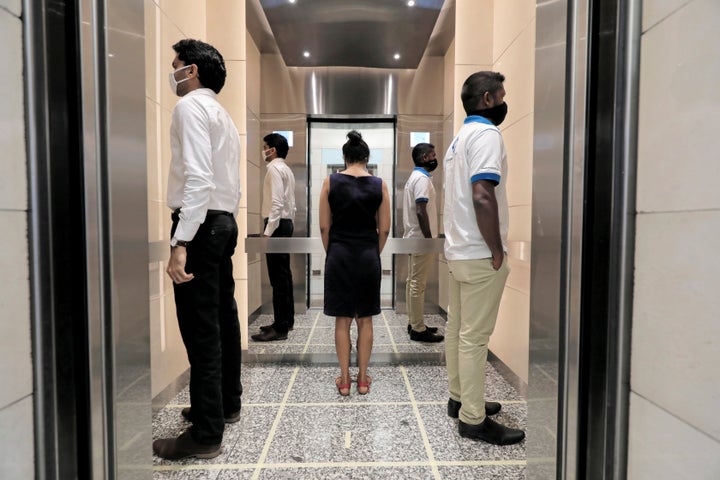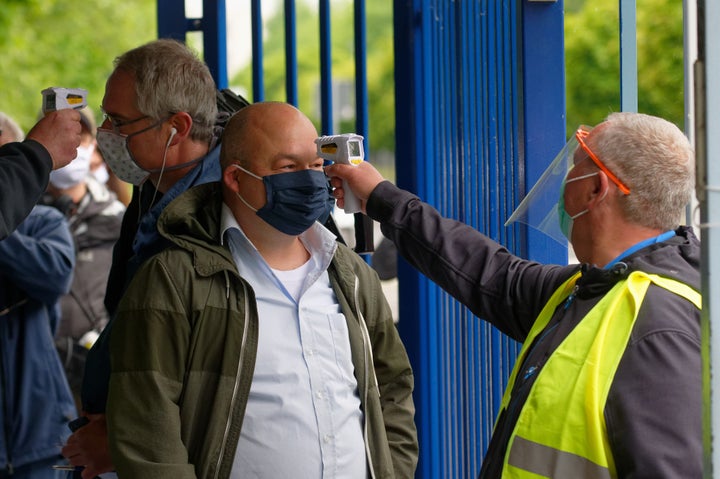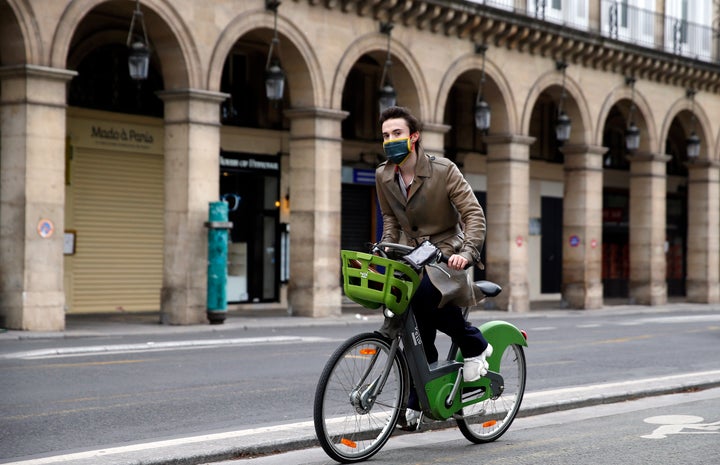For nearly two months, the U.K. government has warned the public to “stay home” in order to curtail the spread of the coronavirus. Now, the emphasis is shifting toward getting people back to work.
“We now need to stress that anyone who can’t work from home — for instance, those in construction or manufacturing — should be actively encouraged to go to work,” Prime Minister Boris Johnson said in an address to the nation on Sunday night.
Johnson’s announcement was short on details, leaving many to wonder how workers might return to work safely. On Tuesday, however, the U.K. government outlined measures that offices, factories, construction sites and other workplaces should implement in order to minimize the risk of infection.
Together with the steps that companies and government officials in other European countries are taking to get people back to work, these guidelines provide a blueprint for what the workplace of the future may look like.
The guidelines stress the need to maintain social distancing and limit personal contact. To achieve those goals, job sites and office spaces will need to be reconfigured, work schedules should be adjusted, and common aspects of work life — such as mingling with colleagues by the coffee machine in the break room or huddling together around a desk — will no longer be feasible.
“Employers have a duty to keep employees safe in the workplace — that is absolutely enshrined in law,” U.K. business secretary Alok Sharma said on Tuesday.
Many workers might cheer the demise of certain elements of professional life, such as endless in-person meetings. Yet for those who look forward to socializing with their colleagues again, the guidelines suggest that offices and job sites will become somewhat foreboding places, requiring dramatic changes in behavior in order to prevent the coronavirus from spreading. Even sharing a pen with a colleague could be risky, the guidance warned.

Plexiglass Screens, Fewer Desks And New Elevator Etiquette
There is no one-size-fits-all approach to minimizing the risk of infection in the workplace. Each employer will need to conduct its own risk assessment and determine which measures are feasible. The approach that officials in the U.K. and other countries are taking, however, suggests that certain measures will likely become commonplace.
In France, government rules require shops and offices to establish a minimum space of 4 square meters per employee (roughly the equivalent of a 6-foot by 7-foot area), according to HuffPost France. If the requirement can’t be met, the company will need to provide masks to its workers.
Work surfaces, toilets and door handles must also be disinfected every day, or even several times a day. If this is not possible, hand sanitizer should be provided nearby.
In Spain, some companies are spreading desks further apart and limiting the number of people allowed in elevators.
The U.K. guidance said workers should be encouraged to use stairs whenever possible, and that if people do use elevators, they should use hand sanitizer and stand facing away from each other.
Inside offices, floor tape and paint should be used to mark off areas and help workers stay 2 meters (approximately 6 feet) apart from each other. Workers should avoid sitting face to face and sharing hot desks. If workstations can’t be spaced out, plexiglass screens may be installed to keep people separated.
Already, plexiglass manufacturers have been experiencing unprecedented demand, as companies rush to install dividers and sneeze guards in shops and offices.
Access to common areas like break rooms and staff cafeterias should be limited to avoid crowding, the guidance said, and employees are encouraged to bring their own food to work. Large meetings and other gatherings are ill-advised.
“There will be more space for staff, fewer people in rooms and the layout of the offices will have to change,” Davide Sala, the head of human resources at the Italian tire company Pirelli, told Reuters.

Temperature Checks And Proximity Wristbands
In addition to reconfiguring their workplaces, some businesses are also turning to high-tech solutions. For example, companies in Spain and the United States have started installing temperature checks at office entrances.
The U.S. Food and Drug Administration is temporarily allowing companies to market infrared thermal camera systems for use in workplaces, such as factories and warehouses, to monitor the temperatures of workers.
Fever is a common symptom of COVID-19, the disease caused by the coronavirus, but studies have revealed that asymptomatic people can also transmit the virus — meaning that temperature checks would not necessarily catch all infected people. And experts warned that temperature scanners may not be accurate and could give companies access to employees’ private medical information.
“I think employers need to look carefully before they jump into any of this,” Michael T. Osterholm, director of the Center for Infectious Disease Research and Policy at the University of Minnesota, told The New York Times. “Some companies are embarking upon things that are not going to help and may actually set us back.”
Other companies are also exploring technological methods to ensure that workers follow social distancing guidelines. A small group of workers at a Ford plant in Michigan are testing the use of “proximity wristbands,” which alert workers when they get too close to colleagues. Workers in the port city of Antwerp, Belgium, are testing similar wristbands this month.
Last month, Ford announced that it would be restarting its main European car factories with enhanced safety measures for workers, including mandatory face masks, temperature checks and reconfigured workspaces.

More Walking, Biking and Working From Home
It’s not enough to simply redesign offices and implement new workplace policies, however. Getting people back to work will also mean ensuring they can travel to their jobs safely.
“We can’t just limit ourselves to demanding that individual companies respect safety protocols in the workplace,” Italy’s prime minister, Giuseppe Conte, said last month. “We also need to assess the number of workers involved in the reopening of a business, how many use public transport or private vehicles, at what time, how densely.”
Italy has been at the forefront of rethinking its approach to public transportation, providing a model for other countries to follow.
The country is working to limit crowding on buses and in train stations, and the transport ministry has suggested that electronic ticket machines will likely become standard, with hand sanitizer dispensers installed nearby. Trains and buses will be disinfected regularly, and the way passengers board and exit vehicles and stations will be adjusted.
It’s clear that daily commutes need to be reconsidered. On Monday, the first day of relaxed lockdown restrictions in France, the Paris metro was packed with riders. Tube platforms in London were crowded as well.
To alleviate such crowding, people who can continue to work from home are being encouraged to do so, while those who do need to travel to work are encouraged to stagger their commutes and use alternate modes of transportation.
“When you do go to work, if possible do so by car — or, even better, by walking or bicycle,” Boris Johnson said during his address on Sunday.
Even if the U.K.’s public transportation network operates at full capacity, social distancing requirements will mean that only 10% of the usual number of passengers will be able to travel, Grant Shapps, the country’s transport minister, said last week.
To compensate for that, the United Kingdom and other countries are widening pedestrian walkways, increasing the number of bike lanes and even closing streets to cars. The U.K. plans to unveil a national cycling plan to help double cycling and increase walking by 2025, and a trial of electric scooters, which was scheduled to take place next year, is being moved up to next month.
In Paris, Mayor Anne Hidalgo announced last week that limits will be imposed on car traffic, and that passengers on public transportation will need to have signed authorization from their employers — or another imperative reason — in order to travel during morning and evening rush hours. The city is also adding thousands of bicycles to Velib, its bike-sharing service.

A New Way of Working
Beyond considering how to reopen their workplaces, many companies are considering whether they even need to.
In New York, Barclays, JPMorgan Chase and Morgan Stanley — three of the biggest commercial tenants in the city — have said it is highly unlikely that all of their employees will return to their offices, according to The New York Times.
On Tuesday, Twitter CEO Jack Dorsey sent an email to employees saying that, if they chose to, they could continue working from home permanently even after the coronavirus pandemic is over.
Nearly 60% of French workers who are working from home hope to keep doing so, either on a regular or ad hoc basis — a position supported by the French government.
“To succeed in deconfinement, companies must make maximum use of telework,” France’s Ministry of Labor said last week.
In many cases, however, working from home is a luxury that is largely reserved for office workers with higher incomes.
In the United States, Starbucks has reopened the vast majority of its locations and asked its employees to return to work — forcing baristas to decide whether they feel safe enough to do so.
Tesla founder Elon Musk announced that the company’s car factory in Fremont, California, would reopen next Monday, in defiance of Alameda County’s coronavirus restrictions.
In the U.K., trade union officials expressed concern about Johnson’s initial announcement that workers should return to their jobs.
Frances O’Grady, general secretary of the Trades Union Congress, which represents the majority of British trade unions, said the prime minister’s address had caused “anxiety” for workers.
Keir Starmer, the leader of the opposition Labour Party, said Johnson appeared to be “effectively telling millions of people to go back to work without a clear plan for safety.”
On Tuesday, however, business secretary Alok Sharma stressed that workers should not be forced to work in an unsafe environment, and that any workers who had safety concerns should speak with their employers or union officials.
With reporting from HuffPost U.K., HuffPost France and Reuters.
A HuffPost Guide To Coronavirus
Calling all HuffPost superfans!
Sign up for membership to become a founding member and help shape HuffPost’s next chapter
Credit: Source link